A Research Study on XYZ Logistics Warehouse Operations and Solutions
VerifiedAdded on 2023/01/19
|59
|12834
|3
Report
AI Summary
This research paper presents a comprehensive study on the operational challenges faced by XYZ Logistics, a newly established warehouse team in Singapore. The study explores the issues stemming from improper warehouse planning and management, impacting client performance. It begins with an introduction, outlining the research aim, objectives, and questions, followed by an extensive literature review covering warehouse logistics, benefits of warehouse management, challenges, and planning factors. The research methodology details the approach, design, and data collection process, including ethical considerations. A case study analyzes findings, including descriptive statistics, and provides discussions and recommendations for improvements. The research aims to identify problems, propose solutions, and contribute to the academic understanding of logistics challenges, offering practical insights for XYZ Logistics and the broader Singapore logistics industry. The report concludes with recommendations and suggestions for future research, aiming to enhance the efficiency and performance of warehouse operations.
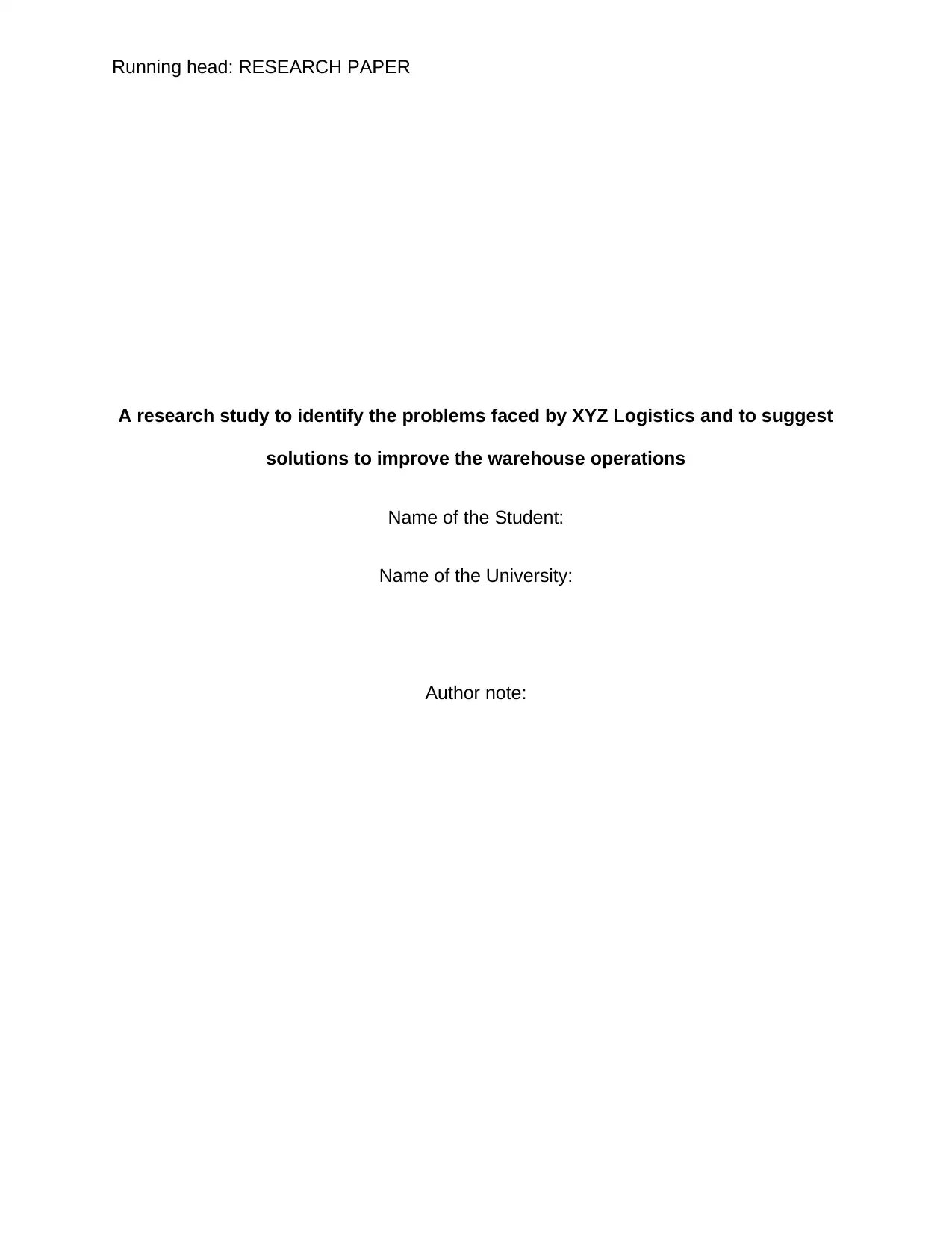
Running head: RESEARCH PAPER
A research study to identify the problems faced by XYZ Logistics and to suggest
solutions to improve the warehouse operations
Name of the Student:
Name of the University:
Author note:
A research study to identify the problems faced by XYZ Logistics and to suggest
solutions to improve the warehouse operations
Name of the Student:
Name of the University:
Author note:
Paraphrase This Document
Need a fresh take? Get an instant paraphrase of this document with our AI Paraphraser
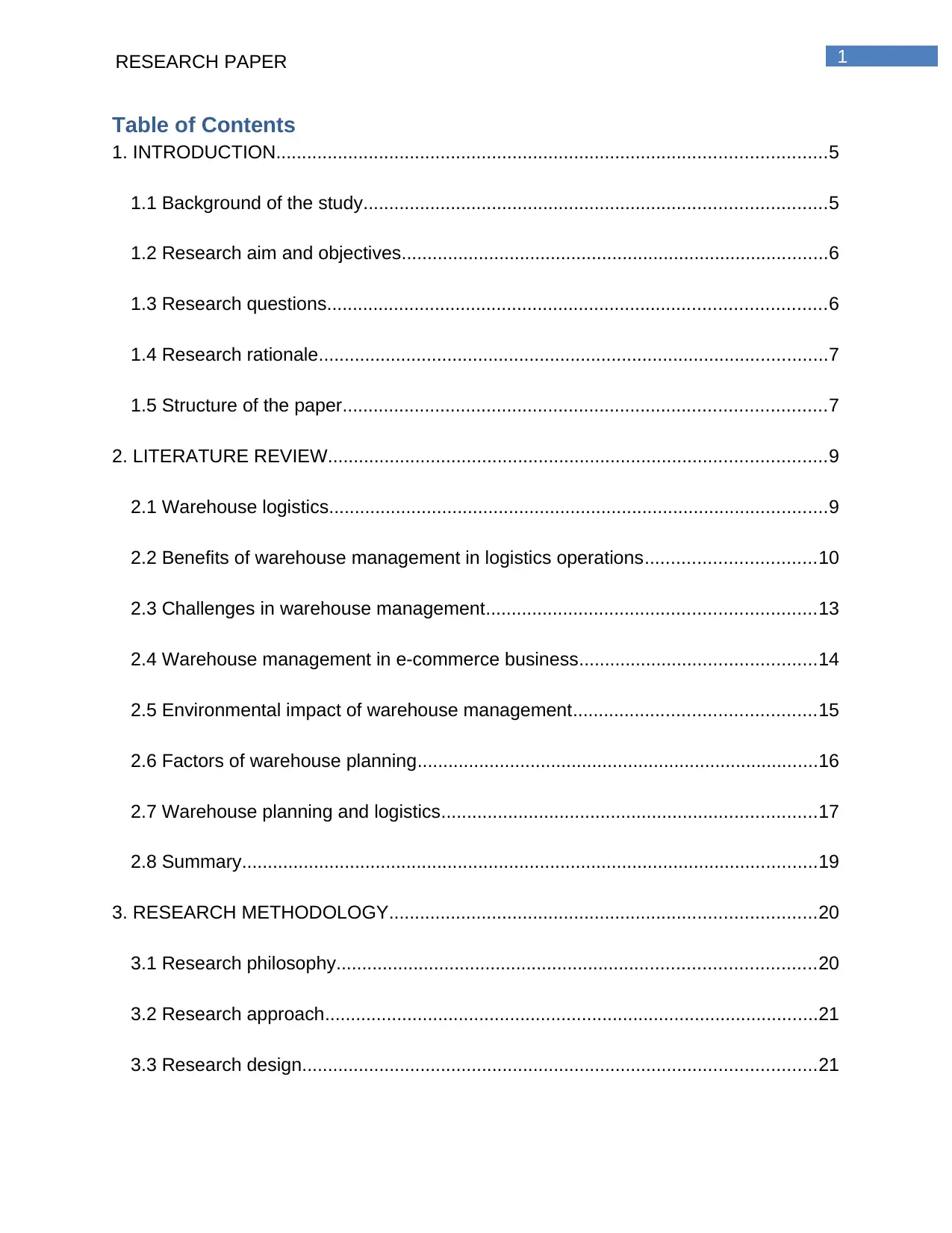
1RESEARCH PAPER
Table of Contents
1. INTRODUCTION...........................................................................................................5
1.1 Background of the study..........................................................................................5
1.2 Research aim and objectives...................................................................................6
1.3 Research questions.................................................................................................6
1.4 Research rationale...................................................................................................7
1.5 Structure of the paper..............................................................................................7
2. LITERATURE REVIEW.................................................................................................9
2.1 Warehouse logistics.................................................................................................9
2.2 Benefits of warehouse management in logistics operations.................................10
2.3 Challenges in warehouse management................................................................13
2.4 Warehouse management in e-commerce business..............................................14
2.5 Environmental impact of warehouse management...............................................15
2.6 Factors of warehouse planning..............................................................................16
2.7 Warehouse planning and logistics.........................................................................17
2.8 Summary................................................................................................................19
3. RESEARCH METHODOLOGY...................................................................................20
3.1 Research philosophy.............................................................................................20
3.2 Research approach................................................................................................21
3.3 Research design....................................................................................................21
Table of Contents
1. INTRODUCTION...........................................................................................................5
1.1 Background of the study..........................................................................................5
1.2 Research aim and objectives...................................................................................6
1.3 Research questions.................................................................................................6
1.4 Research rationale...................................................................................................7
1.5 Structure of the paper..............................................................................................7
2. LITERATURE REVIEW.................................................................................................9
2.1 Warehouse logistics.................................................................................................9
2.2 Benefits of warehouse management in logistics operations.................................10
2.3 Challenges in warehouse management................................................................13
2.4 Warehouse management in e-commerce business..............................................14
2.5 Environmental impact of warehouse management...............................................15
2.6 Factors of warehouse planning..............................................................................16
2.7 Warehouse planning and logistics.........................................................................17
2.8 Summary................................................................................................................19
3. RESEARCH METHODOLOGY...................................................................................20
3.1 Research philosophy.............................................................................................20
3.2 Research approach................................................................................................21
3.3 Research design....................................................................................................21
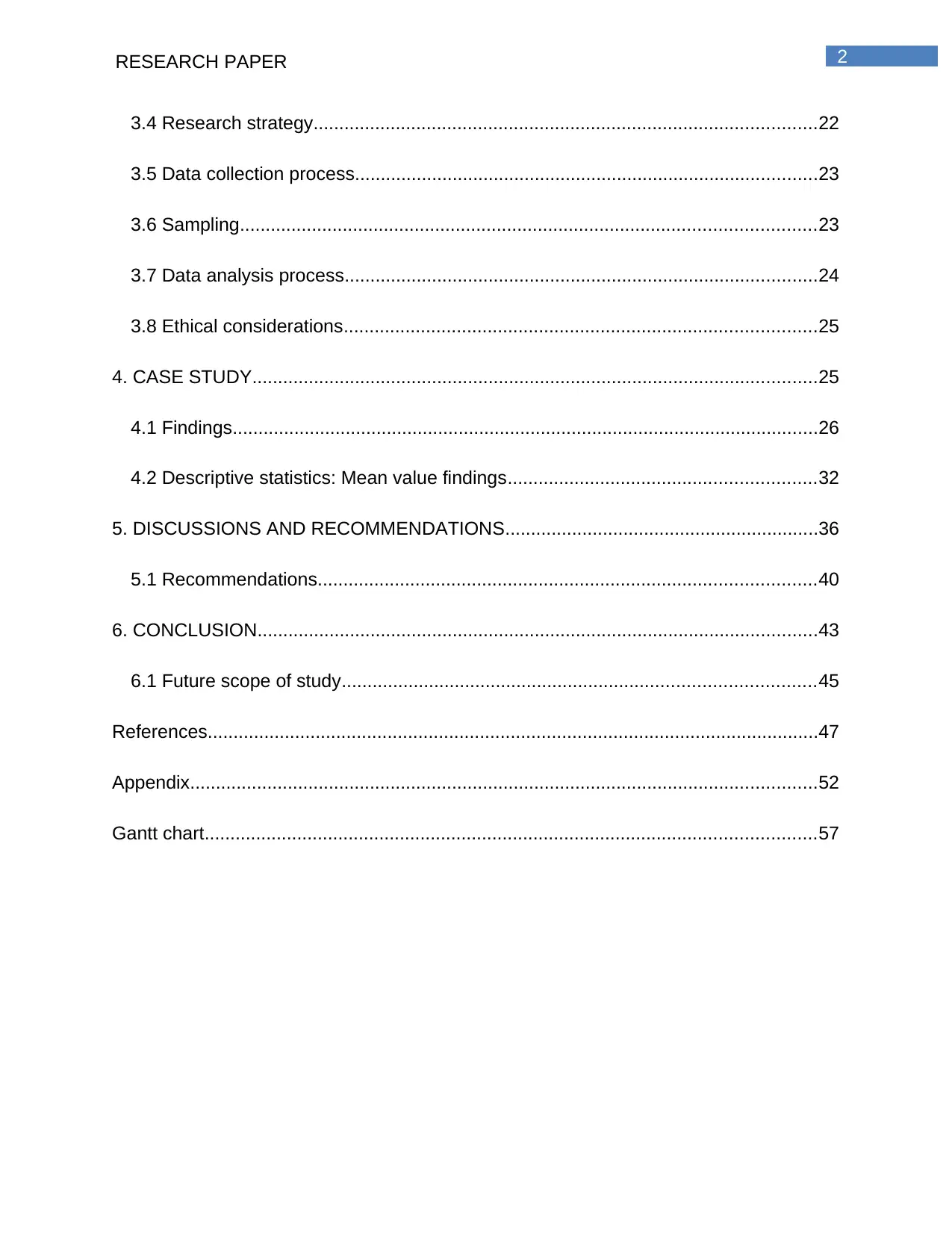
2RESEARCH PAPER
3.4 Research strategy..................................................................................................22
3.5 Data collection process..........................................................................................23
3.6 Sampling................................................................................................................23
3.7 Data analysis process............................................................................................24
3.8 Ethical considerations............................................................................................25
4. CASE STUDY..............................................................................................................25
4.1 Findings..................................................................................................................26
4.2 Descriptive statistics: Mean value findings............................................................32
5. DISCUSSIONS AND RECOMMENDATIONS.............................................................36
5.1 Recommendations.................................................................................................40
6. CONCLUSION.............................................................................................................43
6.1 Future scope of study............................................................................................45
References.......................................................................................................................47
Appendix..........................................................................................................................52
Gantt chart.......................................................................................................................57
3.4 Research strategy..................................................................................................22
3.5 Data collection process..........................................................................................23
3.6 Sampling................................................................................................................23
3.7 Data analysis process............................................................................................24
3.8 Ethical considerations............................................................................................25
4. CASE STUDY..............................................................................................................25
4.1 Findings..................................................................................................................26
4.2 Descriptive statistics: Mean value findings............................................................32
5. DISCUSSIONS AND RECOMMENDATIONS.............................................................36
5.1 Recommendations.................................................................................................40
6. CONCLUSION.............................................................................................................43
6.1 Future scope of study............................................................................................45
References.......................................................................................................................47
Appendix..........................................................................................................................52
Gantt chart.......................................................................................................................57
⊘ This is a preview!⊘
Do you want full access?
Subscribe today to unlock all pages.

Trusted by 1+ million students worldwide
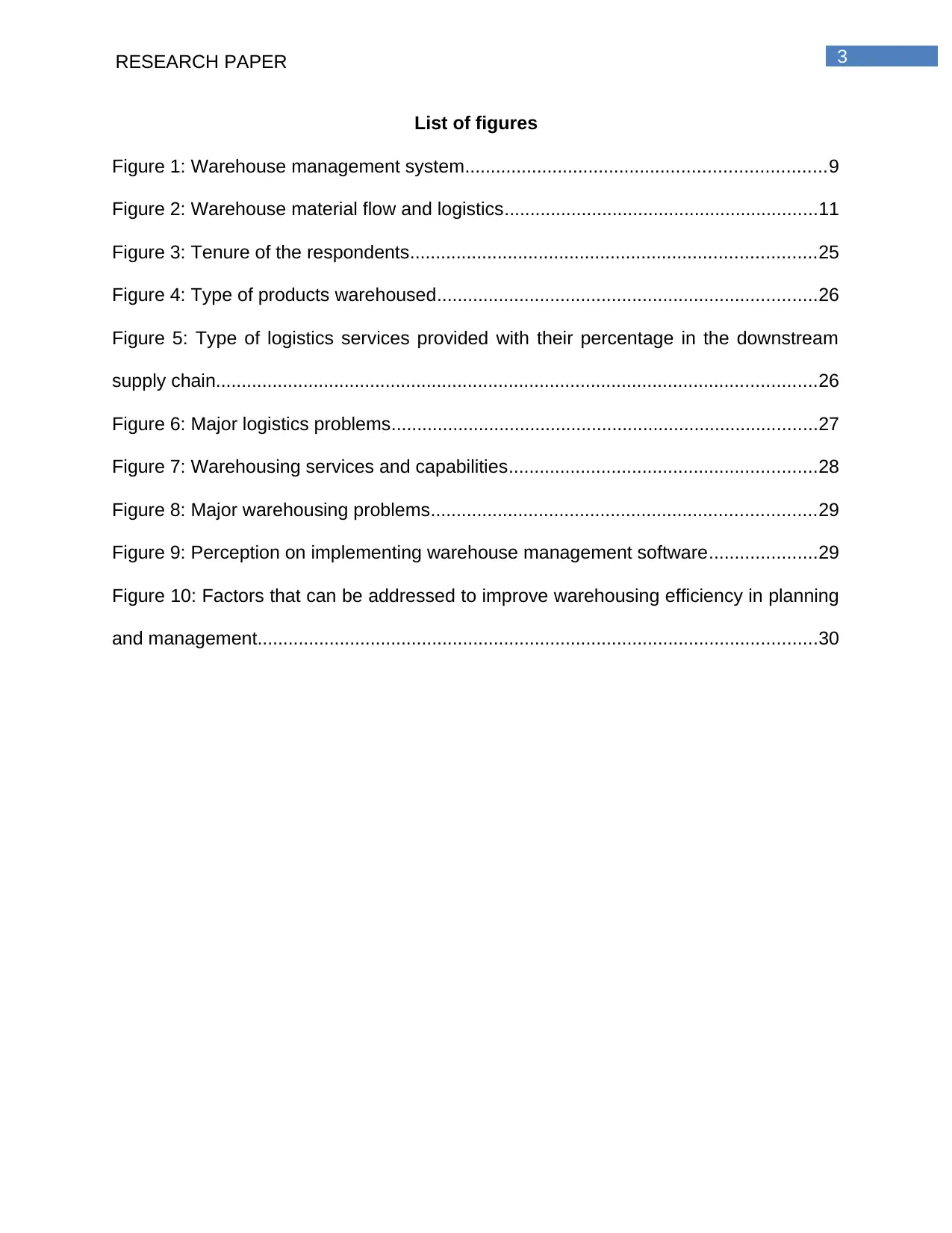
3RESEARCH PAPER
List of figures
Figure 1: Warehouse management system......................................................................9
Figure 2: Warehouse material flow and logistics.............................................................11
Figure 3: Tenure of the respondents...............................................................................25
Figure 4: Type of products warehoused..........................................................................26
Figure 5: Type of logistics services provided with their percentage in the downstream
supply chain.....................................................................................................................26
Figure 6: Major logistics problems...................................................................................27
Figure 7: Warehousing services and capabilities............................................................28
Figure 8: Major warehousing problems...........................................................................29
Figure 9: Perception on implementing warehouse management software.....................29
Figure 10: Factors that can be addressed to improve warehousing efficiency in planning
and management.............................................................................................................30
List of figures
Figure 1: Warehouse management system......................................................................9
Figure 2: Warehouse material flow and logistics.............................................................11
Figure 3: Tenure of the respondents...............................................................................25
Figure 4: Type of products warehoused..........................................................................26
Figure 5: Type of logistics services provided with their percentage in the downstream
supply chain.....................................................................................................................26
Figure 6: Major logistics problems...................................................................................27
Figure 7: Warehousing services and capabilities............................................................28
Figure 8: Major warehousing problems...........................................................................29
Figure 9: Perception on implementing warehouse management software.....................29
Figure 10: Factors that can be addressed to improve warehousing efficiency in planning
and management.............................................................................................................30
Paraphrase This Document
Need a fresh take? Get an instant paraphrase of this document with our AI Paraphraser
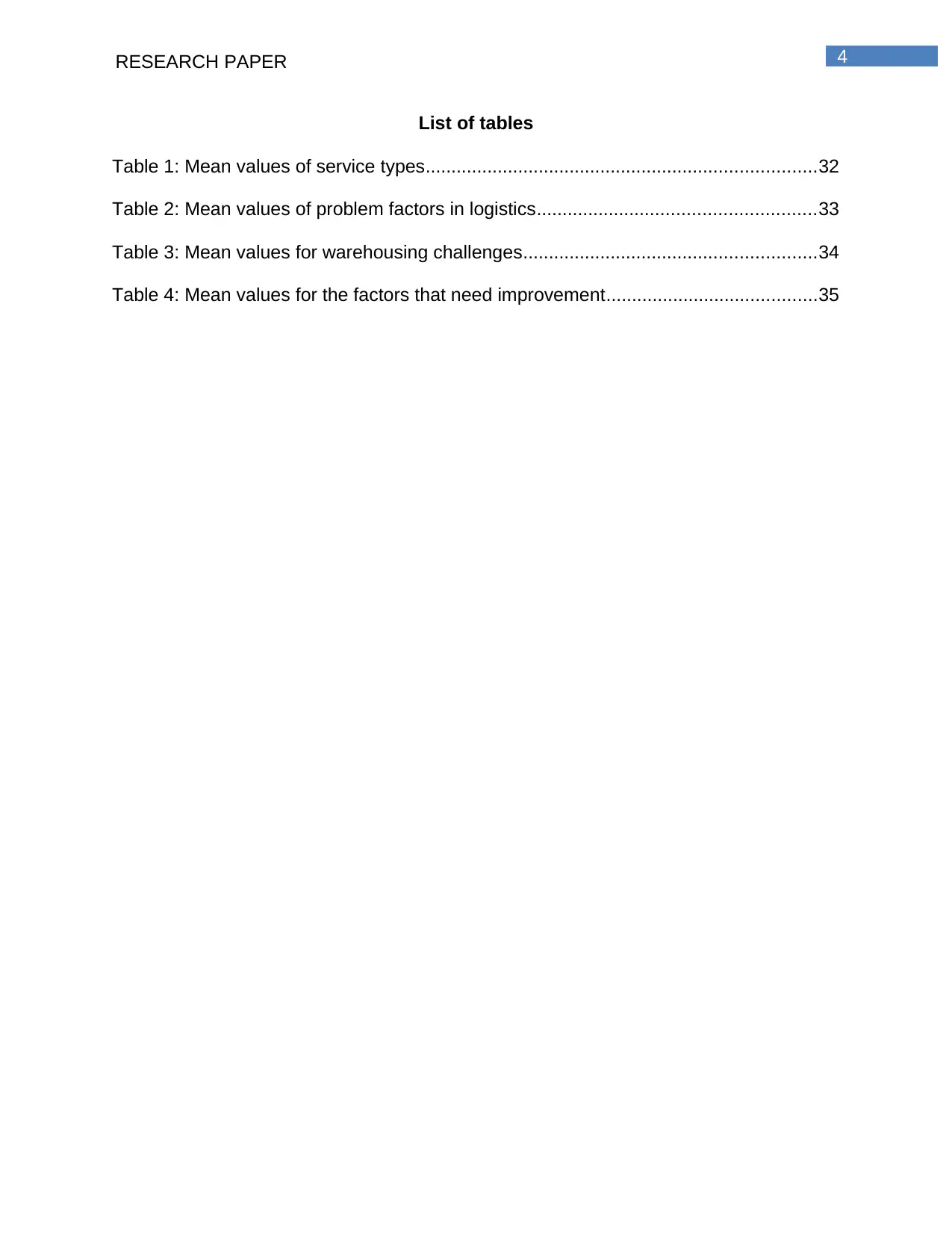
4RESEARCH PAPER
List of tables
Table 1: Mean values of service types............................................................................32
Table 2: Mean values of problem factors in logistics......................................................33
Table 3: Mean values for warehousing challenges.........................................................34
Table 4: Mean values for the factors that need improvement.........................................35
List of tables
Table 1: Mean values of service types............................................................................32
Table 2: Mean values of problem factors in logistics......................................................33
Table 3: Mean values for warehousing challenges.........................................................34
Table 4: Mean values for the factors that need improvement.........................................35
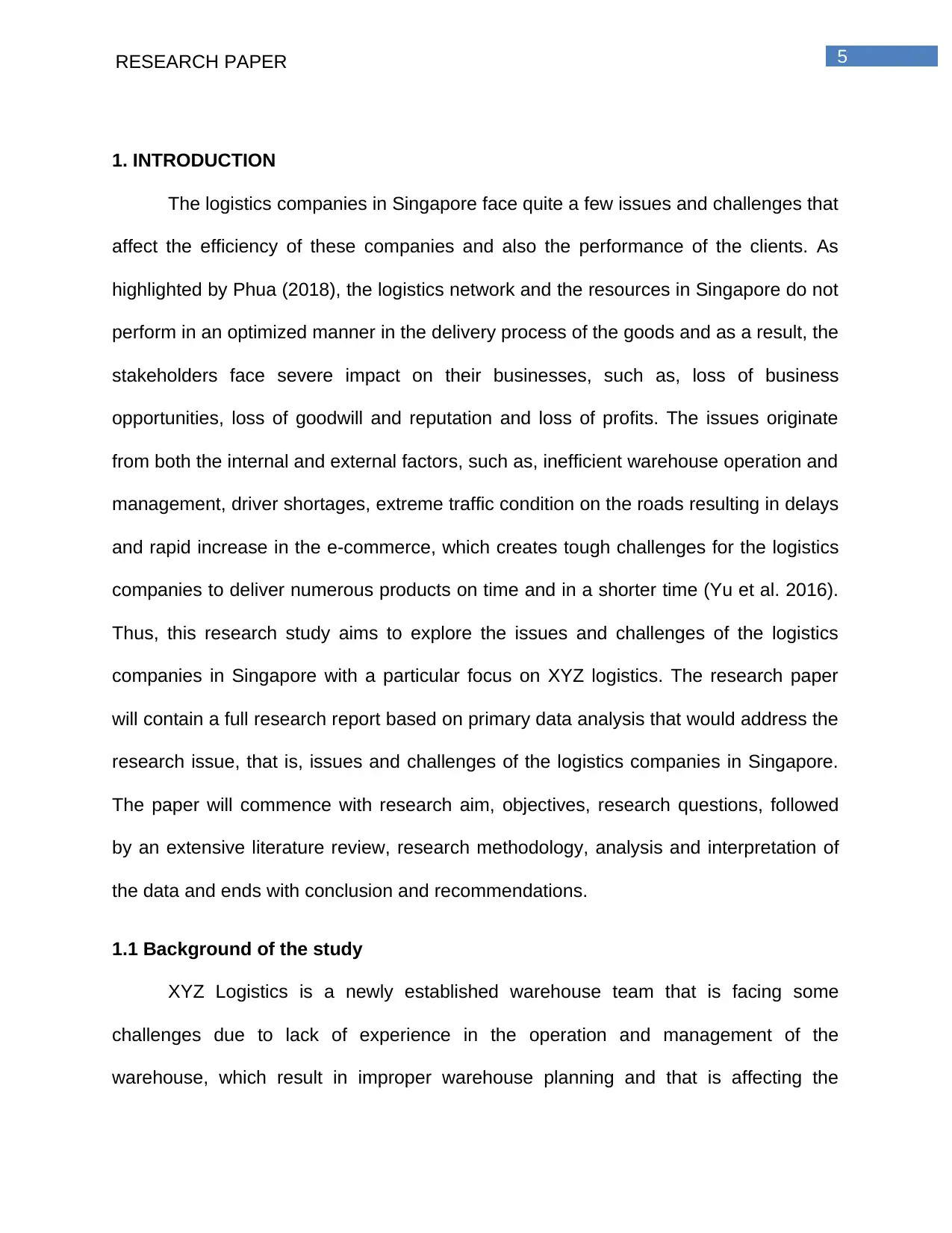
5RESEARCH PAPER
1. INTRODUCTION
The logistics companies in Singapore face quite a few issues and challenges that
affect the efficiency of these companies and also the performance of the clients. As
highlighted by Phua (2018), the logistics network and the resources in Singapore do not
perform in an optimized manner in the delivery process of the goods and as a result, the
stakeholders face severe impact on their businesses, such as, loss of business
opportunities, loss of goodwill and reputation and loss of profits. The issues originate
from both the internal and external factors, such as, inefficient warehouse operation and
management, driver shortages, extreme traffic condition on the roads resulting in delays
and rapid increase in the e-commerce, which creates tough challenges for the logistics
companies to deliver numerous products on time and in a shorter time (Yu et al. 2016).
Thus, this research study aims to explore the issues and challenges of the logistics
companies in Singapore with a particular focus on XYZ logistics. The research paper
will contain a full research report based on primary data analysis that would address the
research issue, that is, issues and challenges of the logistics companies in Singapore.
The paper will commence with research aim, objectives, research questions, followed
by an extensive literature review, research methodology, analysis and interpretation of
the data and ends with conclusion and recommendations.
1.1 Background of the study
XYZ Logistics is a newly established warehouse team that is facing some
challenges due to lack of experience in the operation and management of the
warehouse, which result in improper warehouse planning and that is affecting the
1. INTRODUCTION
The logistics companies in Singapore face quite a few issues and challenges that
affect the efficiency of these companies and also the performance of the clients. As
highlighted by Phua (2018), the logistics network and the resources in Singapore do not
perform in an optimized manner in the delivery process of the goods and as a result, the
stakeholders face severe impact on their businesses, such as, loss of business
opportunities, loss of goodwill and reputation and loss of profits. The issues originate
from both the internal and external factors, such as, inefficient warehouse operation and
management, driver shortages, extreme traffic condition on the roads resulting in delays
and rapid increase in the e-commerce, which creates tough challenges for the logistics
companies to deliver numerous products on time and in a shorter time (Yu et al. 2016).
Thus, this research study aims to explore the issues and challenges of the logistics
companies in Singapore with a particular focus on XYZ logistics. The research paper
will contain a full research report based on primary data analysis that would address the
research issue, that is, issues and challenges of the logistics companies in Singapore.
The paper will commence with research aim, objectives, research questions, followed
by an extensive literature review, research methodology, analysis and interpretation of
the data and ends with conclusion and recommendations.
1.1 Background of the study
XYZ Logistics is a newly established warehouse team that is facing some
challenges due to lack of experience in the operation and management of the
warehouse, which result in improper warehouse planning and that is affecting the
⊘ This is a preview!⊘
Do you want full access?
Subscribe today to unlock all pages.

Trusted by 1+ million students worldwide
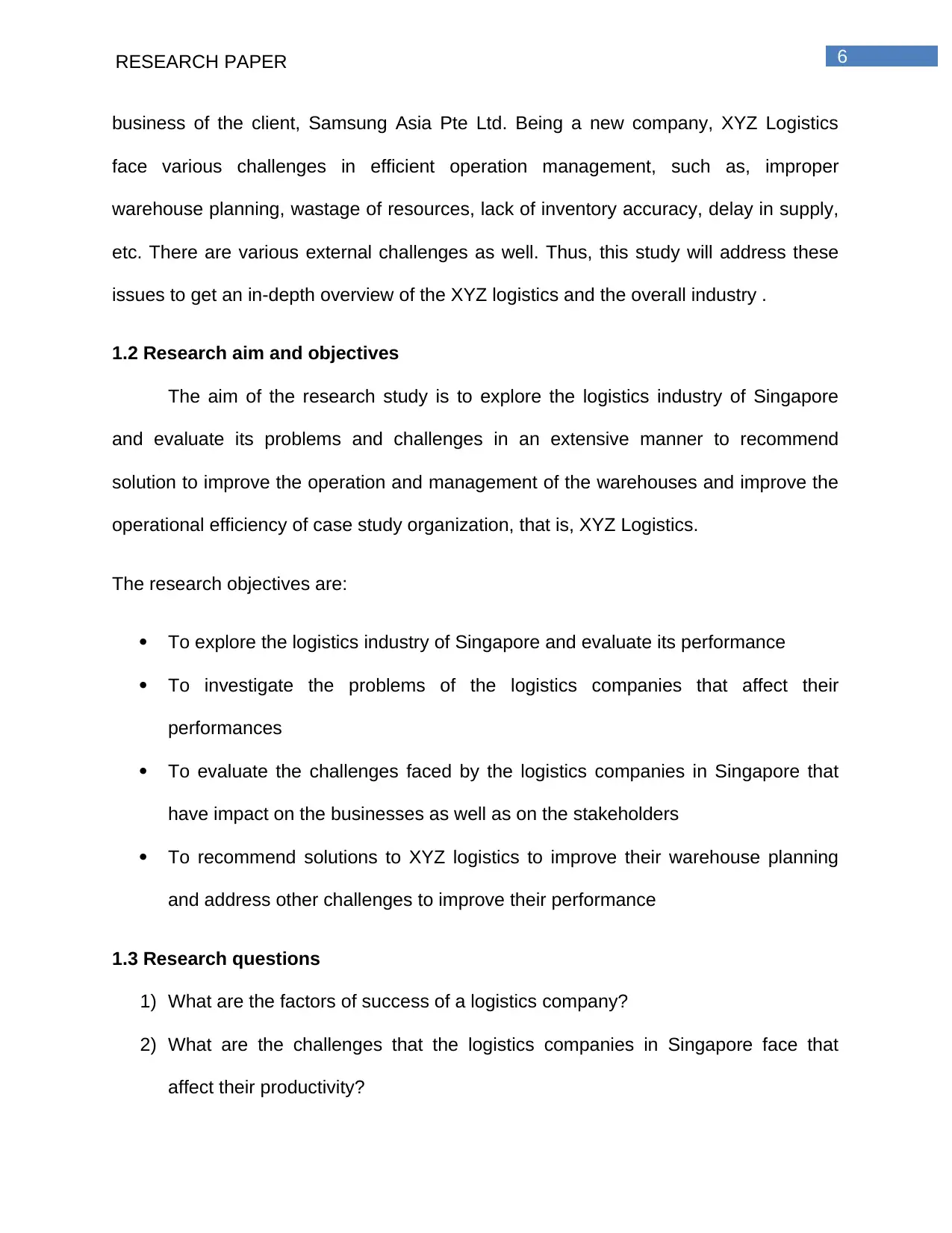
6RESEARCH PAPER
business of the client, Samsung Asia Pte Ltd. Being a new company, XYZ Logistics
face various challenges in efficient operation management, such as, improper
warehouse planning, wastage of resources, lack of inventory accuracy, delay in supply,
etc. There are various external challenges as well. Thus, this study will address these
issues to get an in-depth overview of the XYZ logistics and the overall industry .
1.2 Research aim and objectives
The aim of the research study is to explore the logistics industry of Singapore
and evaluate its problems and challenges in an extensive manner to recommend
solution to improve the operation and management of the warehouses and improve the
operational efficiency of case study organization, that is, XYZ Logistics.
The research objectives are:
To explore the logistics industry of Singapore and evaluate its performance
To investigate the problems of the logistics companies that affect their
performances
To evaluate the challenges faced by the logistics companies in Singapore that
have impact on the businesses as well as on the stakeholders
To recommend solutions to XYZ logistics to improve their warehouse planning
and address other challenges to improve their performance
1.3 Research questions
1) What are the factors of success of a logistics company?
2) What are the challenges that the logistics companies in Singapore face that
affect their productivity?
business of the client, Samsung Asia Pte Ltd. Being a new company, XYZ Logistics
face various challenges in efficient operation management, such as, improper
warehouse planning, wastage of resources, lack of inventory accuracy, delay in supply,
etc. There are various external challenges as well. Thus, this study will address these
issues to get an in-depth overview of the XYZ logistics and the overall industry .
1.2 Research aim and objectives
The aim of the research study is to explore the logistics industry of Singapore
and evaluate its problems and challenges in an extensive manner to recommend
solution to improve the operation and management of the warehouses and improve the
operational efficiency of case study organization, that is, XYZ Logistics.
The research objectives are:
To explore the logistics industry of Singapore and evaluate its performance
To investigate the problems of the logistics companies that affect their
performances
To evaluate the challenges faced by the logistics companies in Singapore that
have impact on the businesses as well as on the stakeholders
To recommend solutions to XYZ logistics to improve their warehouse planning
and address other challenges to improve their performance
1.3 Research questions
1) What are the factors of success of a logistics company?
2) What are the challenges that the logistics companies in Singapore face that
affect their productivity?
Paraphrase This Document
Need a fresh take? Get an instant paraphrase of this document with our AI Paraphraser
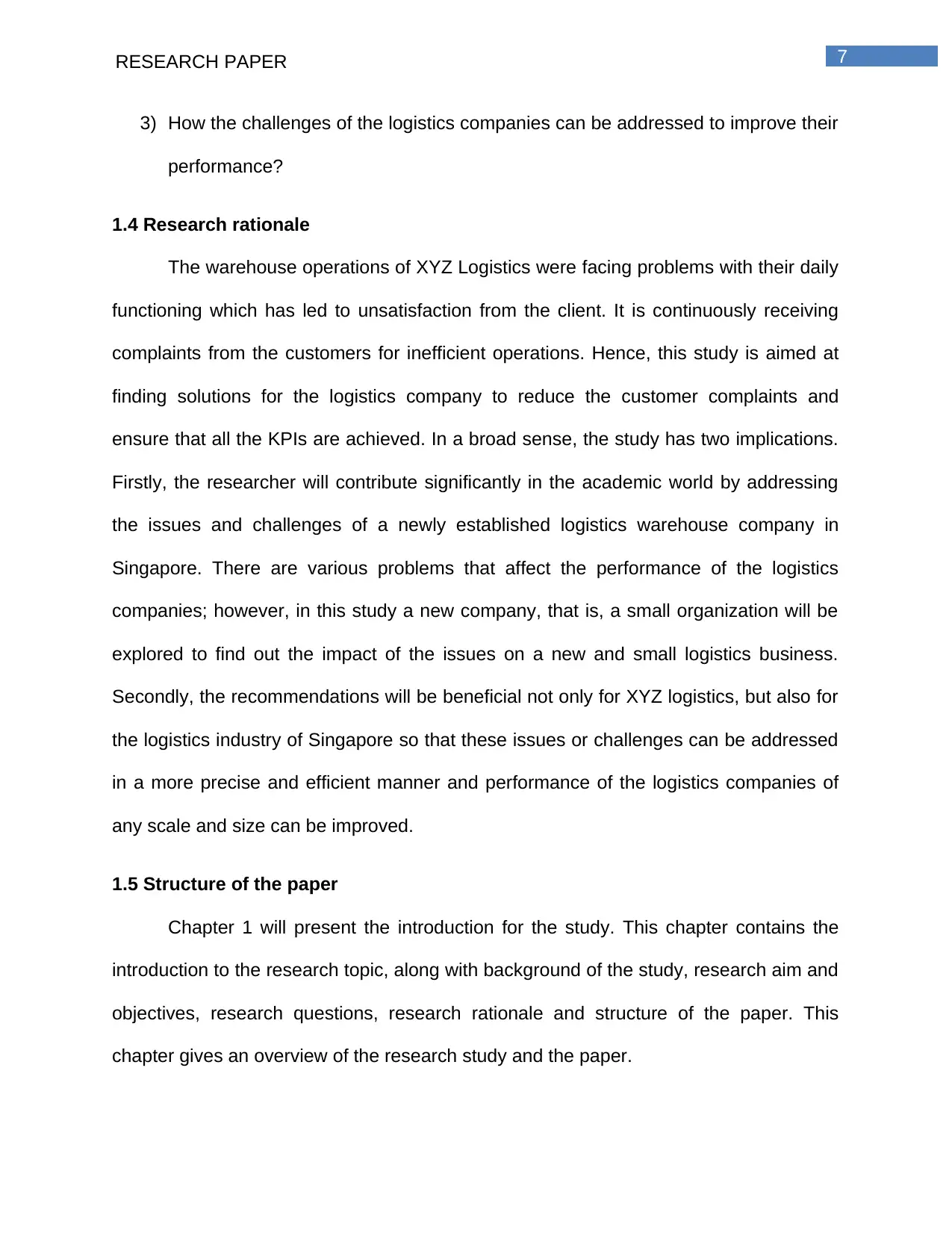
7RESEARCH PAPER
3) How the challenges of the logistics companies can be addressed to improve their
performance?
1.4 Research rationale
The warehouse operations of XYZ Logistics were facing problems with their daily
functioning which has led to unsatisfaction from the client. It is continuously receiving
complaints from the customers for inefficient operations. Hence, this study is aimed at
finding solutions for the logistics company to reduce the customer complaints and
ensure that all the KPIs are achieved. In a broad sense, the study has two implications.
Firstly, the researcher will contribute significantly in the academic world by addressing
the issues and challenges of a newly established logistics warehouse company in
Singapore. There are various problems that affect the performance of the logistics
companies; however, in this study a new company, that is, a small organization will be
explored to find out the impact of the issues on a new and small logistics business.
Secondly, the recommendations will be beneficial not only for XYZ logistics, but also for
the logistics industry of Singapore so that these issues or challenges can be addressed
in a more precise and efficient manner and performance of the logistics companies of
any scale and size can be improved.
1.5 Structure of the paper
Chapter 1 will present the introduction for the study. This chapter contains the
introduction to the research topic, along with background of the study, research aim and
objectives, research questions, research rationale and structure of the paper. This
chapter gives an overview of the research study and the paper.
3) How the challenges of the logistics companies can be addressed to improve their
performance?
1.4 Research rationale
The warehouse operations of XYZ Logistics were facing problems with their daily
functioning which has led to unsatisfaction from the client. It is continuously receiving
complaints from the customers for inefficient operations. Hence, this study is aimed at
finding solutions for the logistics company to reduce the customer complaints and
ensure that all the KPIs are achieved. In a broad sense, the study has two implications.
Firstly, the researcher will contribute significantly in the academic world by addressing
the issues and challenges of a newly established logistics warehouse company in
Singapore. There are various problems that affect the performance of the logistics
companies; however, in this study a new company, that is, a small organization will be
explored to find out the impact of the issues on a new and small logistics business.
Secondly, the recommendations will be beneficial not only for XYZ logistics, but also for
the logistics industry of Singapore so that these issues or challenges can be addressed
in a more precise and efficient manner and performance of the logistics companies of
any scale and size can be improved.
1.5 Structure of the paper
Chapter 1 will present the introduction for the study. This chapter contains the
introduction to the research topic, along with background of the study, research aim and
objectives, research questions, research rationale and structure of the paper. This
chapter gives an overview of the research study and the paper.
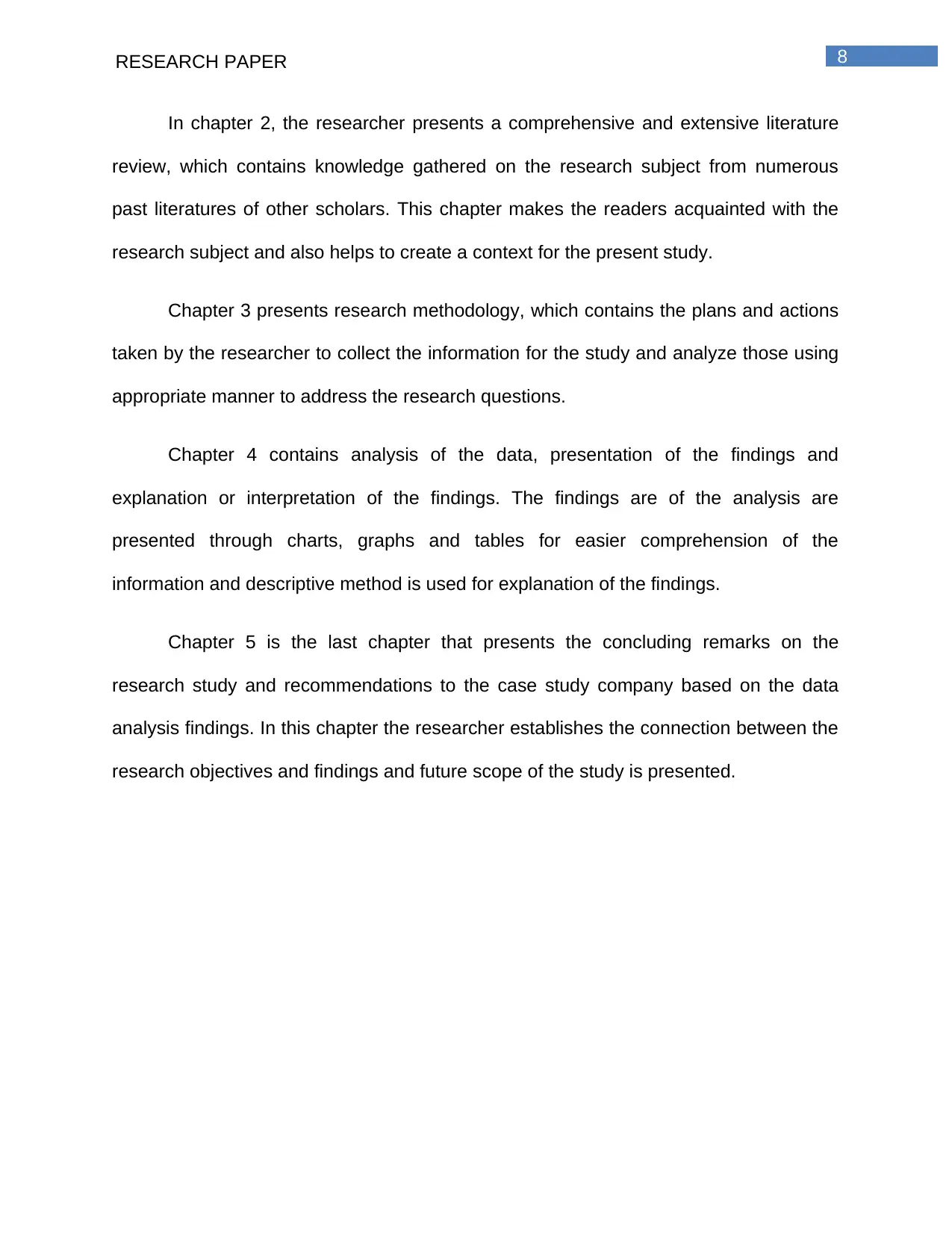
8RESEARCH PAPER
In chapter 2, the researcher presents a comprehensive and extensive literature
review, which contains knowledge gathered on the research subject from numerous
past literatures of other scholars. This chapter makes the readers acquainted with the
research subject and also helps to create a context for the present study.
Chapter 3 presents research methodology, which contains the plans and actions
taken by the researcher to collect the information for the study and analyze those using
appropriate manner to address the research questions.
Chapter 4 contains analysis of the data, presentation of the findings and
explanation or interpretation of the findings. The findings are of the analysis are
presented through charts, graphs and tables for easier comprehension of the
information and descriptive method is used for explanation of the findings.
Chapter 5 is the last chapter that presents the concluding remarks on the
research study and recommendations to the case study company based on the data
analysis findings. In this chapter the researcher establishes the connection between the
research objectives and findings and future scope of the study is presented.
In chapter 2, the researcher presents a comprehensive and extensive literature
review, which contains knowledge gathered on the research subject from numerous
past literatures of other scholars. This chapter makes the readers acquainted with the
research subject and also helps to create a context for the present study.
Chapter 3 presents research methodology, which contains the plans and actions
taken by the researcher to collect the information for the study and analyze those using
appropriate manner to address the research questions.
Chapter 4 contains analysis of the data, presentation of the findings and
explanation or interpretation of the findings. The findings are of the analysis are
presented through charts, graphs and tables for easier comprehension of the
information and descriptive method is used for explanation of the findings.
Chapter 5 is the last chapter that presents the concluding remarks on the
research study and recommendations to the case study company based on the data
analysis findings. In this chapter the researcher establishes the connection between the
research objectives and findings and future scope of the study is presented.
⊘ This is a preview!⊘
Do you want full access?
Subscribe today to unlock all pages.

Trusted by 1+ million students worldwide
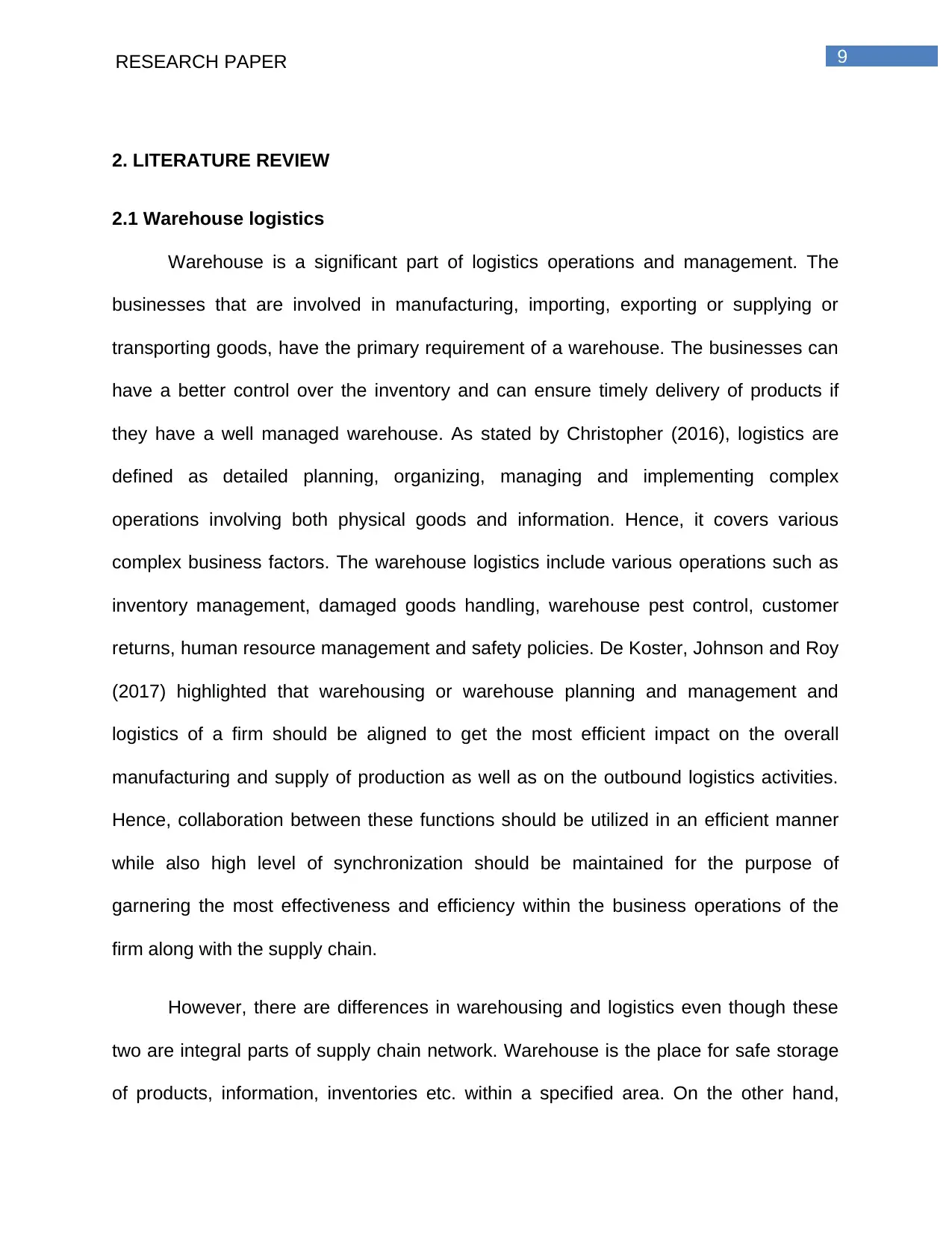
9RESEARCH PAPER
2. LITERATURE REVIEW
2.1 Warehouse logistics
Warehouse is a significant part of logistics operations and management. The
businesses that are involved in manufacturing, importing, exporting or supplying or
transporting goods, have the primary requirement of a warehouse. The businesses can
have a better control over the inventory and can ensure timely delivery of products if
they have a well managed warehouse. As stated by Christopher (2016), logistics are
defined as detailed planning, organizing, managing and implementing complex
operations involving both physical goods and information. Hence, it covers various
complex business factors. The warehouse logistics include various operations such as
inventory management, damaged goods handling, warehouse pest control, customer
returns, human resource management and safety policies. De Koster, Johnson and Roy
(2017) highlighted that warehousing or warehouse planning and management and
logistics of a firm should be aligned to get the most efficient impact on the overall
manufacturing and supply of production as well as on the outbound logistics activities.
Hence, collaboration between these functions should be utilized in an efficient manner
while also high level of synchronization should be maintained for the purpose of
garnering the most effectiveness and efficiency within the business operations of the
firm along with the supply chain.
However, there are differences in warehousing and logistics even though these
two are integral parts of supply chain network. Warehouse is the place for safe storage
of products, information, inventories etc. within a specified area. On the other hand,
2. LITERATURE REVIEW
2.1 Warehouse logistics
Warehouse is a significant part of logistics operations and management. The
businesses that are involved in manufacturing, importing, exporting or supplying or
transporting goods, have the primary requirement of a warehouse. The businesses can
have a better control over the inventory and can ensure timely delivery of products if
they have a well managed warehouse. As stated by Christopher (2016), logistics are
defined as detailed planning, organizing, managing and implementing complex
operations involving both physical goods and information. Hence, it covers various
complex business factors. The warehouse logistics include various operations such as
inventory management, damaged goods handling, warehouse pest control, customer
returns, human resource management and safety policies. De Koster, Johnson and Roy
(2017) highlighted that warehousing or warehouse planning and management and
logistics of a firm should be aligned to get the most efficient impact on the overall
manufacturing and supply of production as well as on the outbound logistics activities.
Hence, collaboration between these functions should be utilized in an efficient manner
while also high level of synchronization should be maintained for the purpose of
garnering the most effectiveness and efficiency within the business operations of the
firm along with the supply chain.
However, there are differences in warehousing and logistics even though these
two are integral parts of supply chain network. Warehouse is the place for safe storage
of products, information, inventories etc. within a specified area. On the other hand,
Paraphrase This Document
Need a fresh take? Get an instant paraphrase of this document with our AI Paraphraser
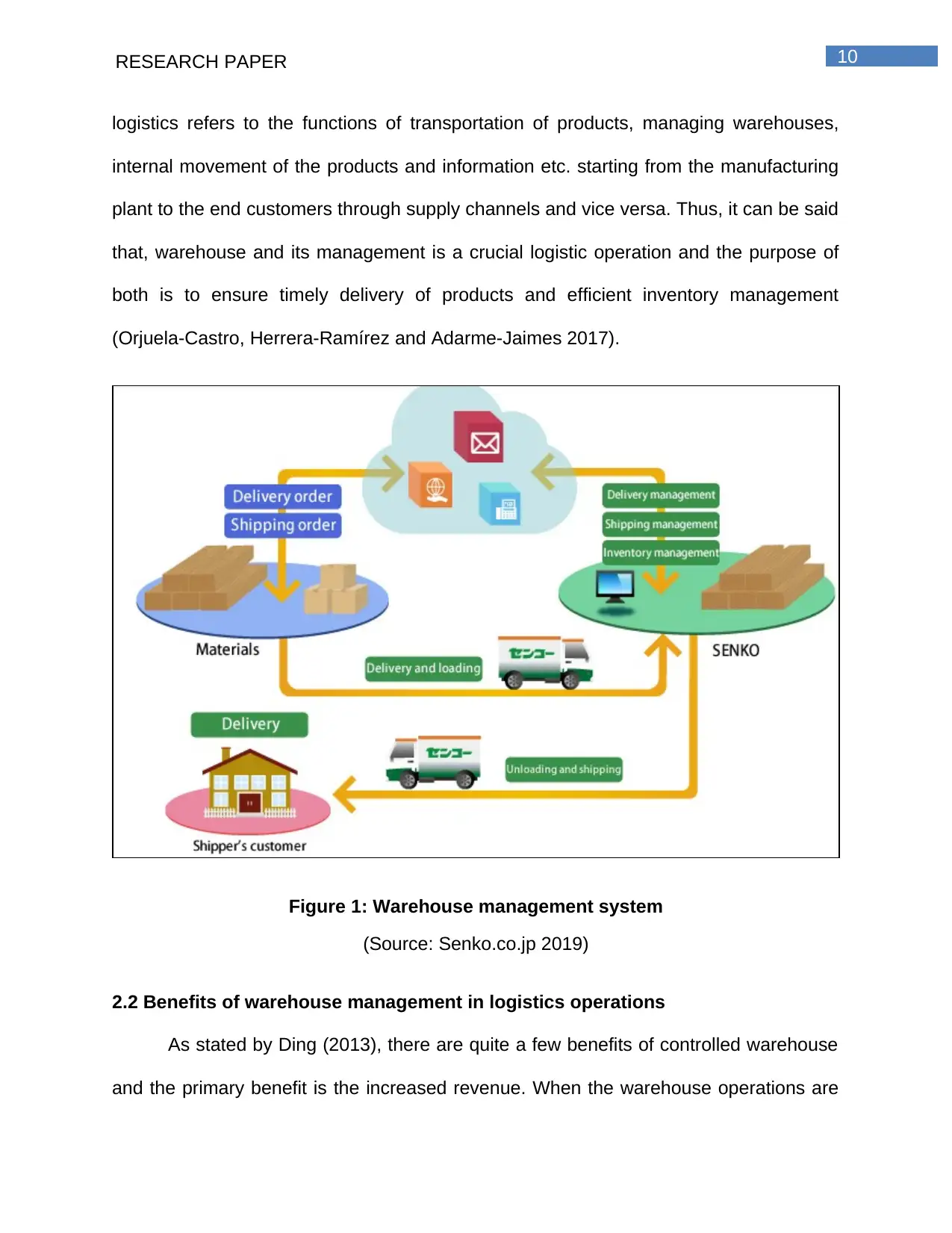
10RESEARCH PAPER
logistics refers to the functions of transportation of products, managing warehouses,
internal movement of the products and information etc. starting from the manufacturing
plant to the end customers through supply channels and vice versa. Thus, it can be said
that, warehouse and its management is a crucial logistic operation and the purpose of
both is to ensure timely delivery of products and efficient inventory management
(Orjuela-Castro, Herrera-Ramírez and Adarme-Jaimes 2017).
Figure 1: Warehouse management system
(Source: Senko.co.jp 2019)
2.2 Benefits of warehouse management in logistics operations
As stated by Ding (2013), there are quite a few benefits of controlled warehouse
and the primary benefit is the increased revenue. When the warehouse operations are
logistics refers to the functions of transportation of products, managing warehouses,
internal movement of the products and information etc. starting from the manufacturing
plant to the end customers through supply channels and vice versa. Thus, it can be said
that, warehouse and its management is a crucial logistic operation and the purpose of
both is to ensure timely delivery of products and efficient inventory management
(Orjuela-Castro, Herrera-Ramírez and Adarme-Jaimes 2017).
Figure 1: Warehouse management system
(Source: Senko.co.jp 2019)
2.2 Benefits of warehouse management in logistics operations
As stated by Ding (2013), there are quite a few benefits of controlled warehouse
and the primary benefit is the increased revenue. When the warehouse operations are
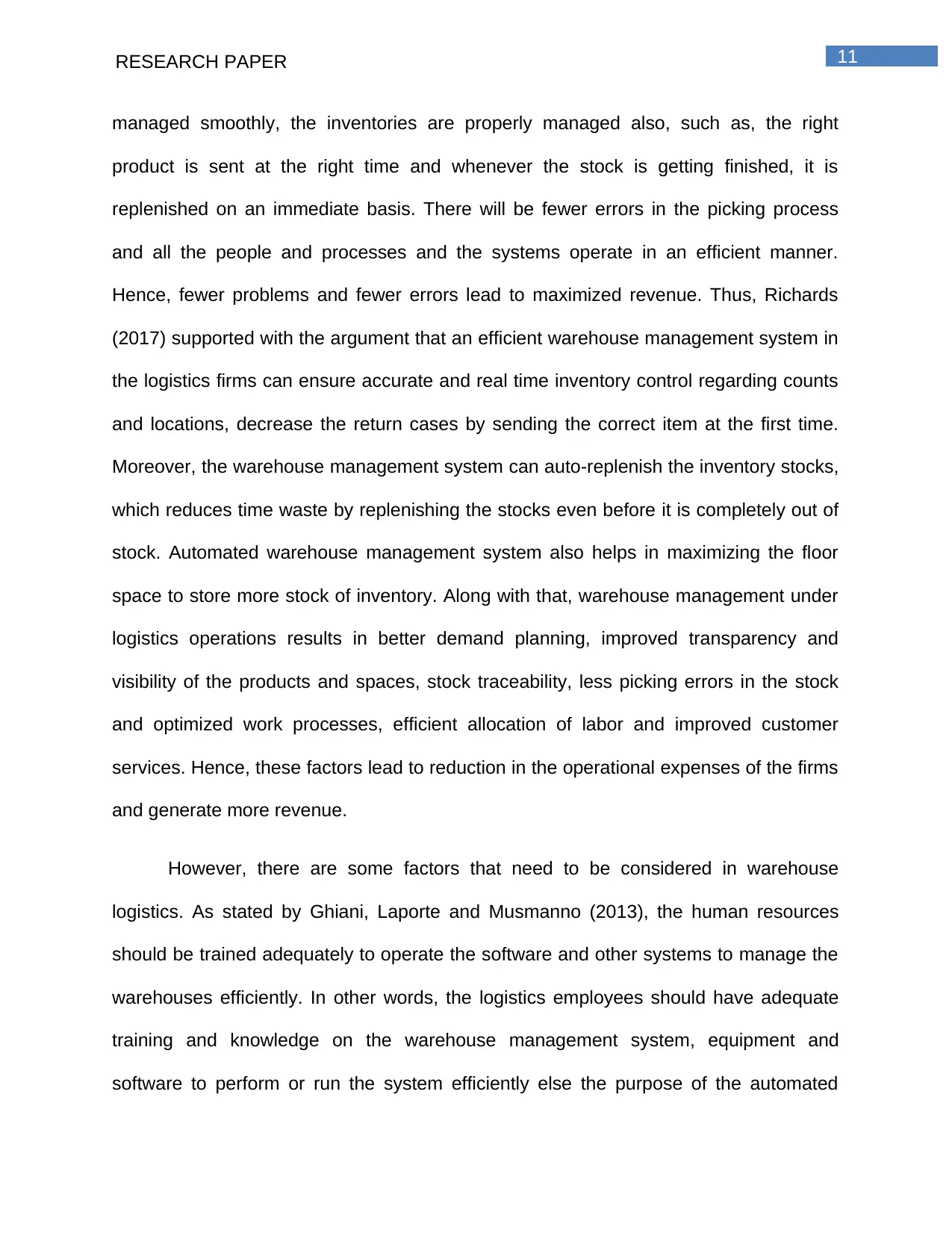
11RESEARCH PAPER
managed smoothly, the inventories are properly managed also, such as, the right
product is sent at the right time and whenever the stock is getting finished, it is
replenished on an immediate basis. There will be fewer errors in the picking process
and all the people and processes and the systems operate in an efficient manner.
Hence, fewer problems and fewer errors lead to maximized revenue. Thus, Richards
(2017) supported with the argument that an efficient warehouse management system in
the logistics firms can ensure accurate and real time inventory control regarding counts
and locations, decrease the return cases by sending the correct item at the first time.
Moreover, the warehouse management system can auto-replenish the inventory stocks,
which reduces time waste by replenishing the stocks even before it is completely out of
stock. Automated warehouse management system also helps in maximizing the floor
space to store more stock of inventory. Along with that, warehouse management under
logistics operations results in better demand planning, improved transparency and
visibility of the products and spaces, stock traceability, less picking errors in the stock
and optimized work processes, efficient allocation of labor and improved customer
services. Hence, these factors lead to reduction in the operational expenses of the firms
and generate more revenue.
However, there are some factors that need to be considered in warehouse
logistics. As stated by Ghiani, Laporte and Musmanno (2013), the human resources
should be trained adequately to operate the software and other systems to manage the
warehouses efficiently. In other words, the logistics employees should have adequate
training and knowledge on the warehouse management system, equipment and
software to perform or run the system efficiently else the purpose of the automated
managed smoothly, the inventories are properly managed also, such as, the right
product is sent at the right time and whenever the stock is getting finished, it is
replenished on an immediate basis. There will be fewer errors in the picking process
and all the people and processes and the systems operate in an efficient manner.
Hence, fewer problems and fewer errors lead to maximized revenue. Thus, Richards
(2017) supported with the argument that an efficient warehouse management system in
the logistics firms can ensure accurate and real time inventory control regarding counts
and locations, decrease the return cases by sending the correct item at the first time.
Moreover, the warehouse management system can auto-replenish the inventory stocks,
which reduces time waste by replenishing the stocks even before it is completely out of
stock. Automated warehouse management system also helps in maximizing the floor
space to store more stock of inventory. Along with that, warehouse management under
logistics operations results in better demand planning, improved transparency and
visibility of the products and spaces, stock traceability, less picking errors in the stock
and optimized work processes, efficient allocation of labor and improved customer
services. Hence, these factors lead to reduction in the operational expenses of the firms
and generate more revenue.
However, there are some factors that need to be considered in warehouse
logistics. As stated by Ghiani, Laporte and Musmanno (2013), the human resources
should be trained adequately to operate the software and other systems to manage the
warehouses efficiently. In other words, the logistics employees should have adequate
training and knowledge on the warehouse management system, equipment and
software to perform or run the system efficiently else the purpose of the automated
⊘ This is a preview!⊘
Do you want full access?
Subscribe today to unlock all pages.

Trusted by 1+ million students worldwide
1 out of 59
Related Documents
Your All-in-One AI-Powered Toolkit for Academic Success.
+13062052269
info@desklib.com
Available 24*7 on WhatsApp / Email
![[object Object]](/_next/static/media/star-bottom.7253800d.svg)
Unlock your academic potential
Copyright © 2020–2025 A2Z Services. All Rights Reserved. Developed and managed by ZUCOL.




